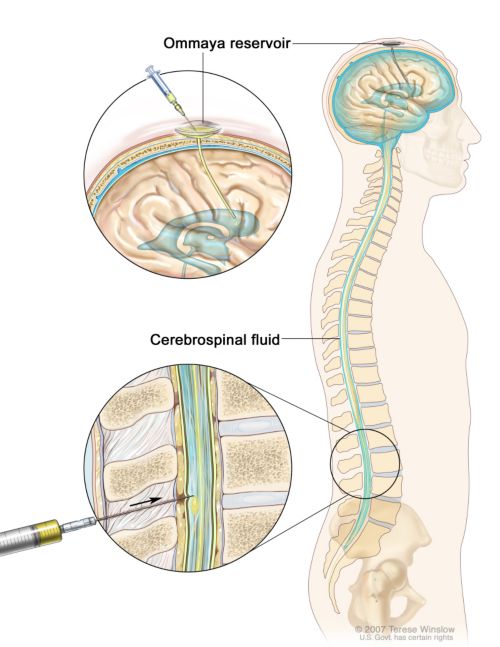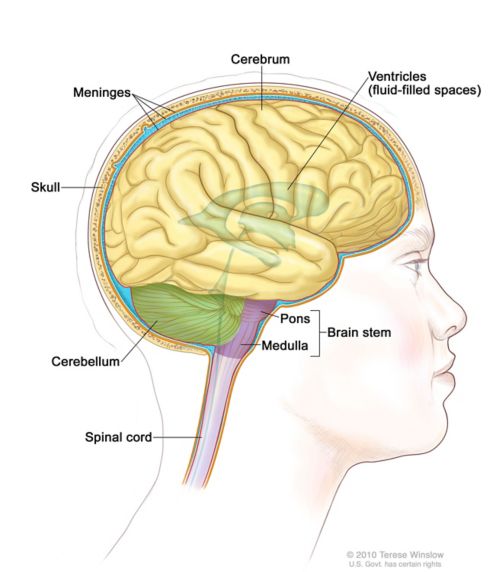Ommaya Reservoir (Intraventricular Reservoir)
What is an Ommaya reservoir?
An Ommaya reservoir (also called an intraventricular reservoir) is a 2-part device that a neurosurgeon places on top of and inside of a child’s brain. A reservoir is a place where fluid collects.
- The first part of the reservoir is a soft, dome-shaped device placed under the child’s scalp, on top of their brain.
- The second part is a thin flexible tube called a catheter. This part connects to the dome and goes between the ventricles in the child’s brain. The ventricles are hollow, fluid-filled spaces in the brain.
The ventricles of the brain make cerebrospinal fluid (CSF), often called spinal fluid. Spinal fluid flows around your child’s brain and spinal cord. It cushions the brain and spinal cord to protect them from injury. Spinal fluid also brings nutrients to the brain and carries away waste products. Nutrients are substances that the body needs to function and maintain health.
Benefits of an Ommaya reservoir
An Ommaya reservoir helps your child’s care team:
- Take samples of your child’s spinal fluid: This is called a reservoir tap. A health care provider removes fluid with a needle. The fluid samples can show if cancer cells are present or if your child has an infection.
- Remove spinal fluid when there is too much: If your child has too much spinal fluid in their brain or swelling in the brain, it can help to remove some of the fluid.
- Give medicines to your child’s spinal fluid: Medicines given through the reservoir can include chemotherapy, antibiotics, and other treatments.
How to prepare for Ommaya reservoir placement
Follow all instructions given to you by your surgical care team to prepare your child for this procedure.
What to expect during Ommaya reservoir placement
Your child’s neurosurgeon places the reservoir during a surgical procedure. Your child will likely have general anesthesia. That means they will be asleep for the procedure. A member of the care team shaves the area where the surgical cuts will be made. They do not shave your child’s entire head.
During the procedure, your child’s neurosurgeon makes a small cut behind your child’s hairline. They insert the reservoir dome through the cut under the scalp. The neurosurgeon then passes the catheter through the brain into the space where spinal fluid is made. Then they stitch the cut closed.
This placement surgery usually takes about an hour.
After Ommaya reservoir placement
Your child’s doctor will talk with you after the surgery. Your child may have bandages over the procedure site. They may need to stay in the hospital for some time as they heal. The care team will ask your child to move their fingers, toes, arms, and legs. They will also check the pupils of your child’s eyes and ask your child questions.
Your child may have a headache, nausea, or vomiting after Ommaya reservoir placement. Please tell your care team if your child is in pain or has any of the above symptoms. They can give medicines to help.
Your child may have mild swelling around their procedure site. Call your care team if you see any redness, drainage or swelling that is not mild or if you have any concerns.
Call your surgical care team if you have any questions.
Possible risks of Ommaya reservoir placement
Your child’s neurosurgeon will talk with you about the risks of the procedure. There is a small risk of:
- Bleeding into the brain
- Infection in the brain
- The Ommaya reservoir being out of place. If the reservoir needs to be moved, a follow-up procedure may be needed.
- The Ommaya reservoir not working properly. Your child may have an MRI or CT scan after the operation to make sure that the reservoir works correctly.
When to call your care team
Call your care team right away if your child has any signs or symptoms of infection.
Signs and symptoms of infection include:
- A fever of 100.4°F (38°C) or higher
- Soreness, swelling, or redness around the reservoir
- Bad-smelling discharge from around the reservoir
- Headaches
- Vomiting
- Neck stiffness
- Blurry vision
- Confusion
Questions to ask your care team
- How should my child prepare for their Ommaya reservoir placement?
- Does the reservoir have any side effects?
- Can the reservoir be removed?
- Should my child limit or avoid certain activities after Ommaya reservoir surgery?
- How do we care for the reservoir? Do we need to clean it?
- What happens during a reservoir tap?
Key points about your child’s Ommaya reservoir
- An Ommaya reservoir (intraventricular reservoir) is a device placed next to your child’s brain. It allows the care team to take samples of their spinal fluid and give medicine directly into the brain and spinal cord.
- The reservoir is placed during surgery.
- Contact your child’s care team if your child has any signs or symptoms of infection after the reservoir is placed.
-
Etoposide
Etoposide is a type of chemotherapy. It works by slowing or stopping the growth of cells. It may be taken as a capsule or liquid by mouth, given as a liquid by IV, or given into the cerebrospinal fluid.
-
Craniopharyngioma
Craniopharyngiomas are rare brain tumors located near the pituitary gland and hypothalamus. Learn about symptoms, diagnosis, and treatment of craniopharyngioma in children and teens.
-
Chemotherapy
Chemotherapy treats cancer using medicines that work by interfering with cells as they divide. Learn more about chemo and how to prepare your child for it.


